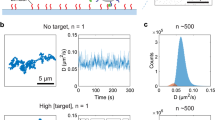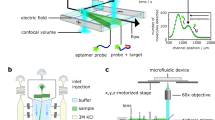Abstract
The development of reagentless sensors that can detect molecular analytes in biological fluids could enable a broad range of applications in personalized health monitoring. However, only a limited set of molecular inputs can currently be detected using reagentless sensors. Here, we report a sensing mechanism that is compatible with the analysis of proteins that are important physiological markers of stress, allergy, cardiovascular health, inflammation and cancer. The sensing method is based on the motion of an inverted molecular pendulum that exhibits field-induced transport modulated by the presence of a bound analyte. We measure the sensor’s electric field-mediated transport using the electron-transfer kinetics of an attached reporter molecule. Using time-resolved electrochemical measurements that enable unidirectional motion of our sensor, the presence of an analyte bound to our sensor complex can be tracked continuously in real time. We show that this sensing approach is compatible with making measurements in blood, saliva, urine, tears and sweat and that the sensors can collect data in situ in living animals.

This is a preview of subscription content, access via your institution
Access options
Access Nature and 54 other Nature Portfolio journals
Get Nature+, our best-value online-access subscription
$29.99 / 30 days
cancel any time
Subscribe to this journal
Receive 12 print issues and online access
$259.00 per year
only $21.58 per issue
Buy this article
- Purchase on Springer Link
- Instant access to full article PDF
Prices may be subject to local taxes which are calculated during checkout




Similar content being viewed by others
Data availability
The main data supporting the findings of the current study are available within the paper and its Supplementary Information. Data for figures in the Supplementary Information are included as additional Supplementary files. Data for chemical and physical protein parameters were derived from UniProt (https://www.uniprot.org/) and PhosphoSitePlus (https://www.phosphosite.org/). Source data are provided with this paper.
Code availability
The code corresponding to the theoretical model for the MP can be accessed at https://github.com/sgomis/MP-biosensor.
References
Kim, J., Campbell, A. S., de Ávila, B. E. F. & Wang, J. Wearable biosensors for healthcare monitoring. Nat. Biotechnol. 37, 389–406 (2019).
Bandodkar, A. J., Jeang, W. J., Ghaffari, R. & Rogers, J. A. Wearable sensors for biochemical sweat analysis. Annu. Rev. Anal. Chem. 12, 1–22 (2019).
Giljohann, D. A. & Mirkin, C. A. Drivers of biodiagnostic development. Nature 462, 461–464 (2009).
Gaster, R. S. et al. Matrix-insensitive protein assays push the limits of biosensors in medicine. Nat. Med. 15, 1327–1332 (2009).
Rong, G., Corrie, S. R. & Clark, H. A. In vivo biosensing: progress and perspectives. ACS Sens. 2, 327–338 (2017).
Gao, W. et al. Fully integrated wearable sensor arrays for multiplexed in situ perspiration analysis. Nature 529, 509–514 (2016).
Wassum, K. M. et al. Transient extracellular glutamate events in the basolateral amygdala track reward-seeking actions. J. Neurosci. 32, 2734–2746 (2012).
Sarter, M. & Kim, Y. Interpreting chemical neurotransmission in vivo: techniques, time scales and theories. ACS Chem. Neurosci. 6, 8–10 (2015).
Lipani, L. et al. Non-invasive, transdermal, path-selective and specific glucose monitoring via a graphene-based platform. Nat. Nanotechnol. 13, 504–511 (2018).
Lee, H. et al. A graphene-based electrochemical device with thermoresponsive microneedles for diabetes monitoring and therapy. Nat. Nanotechnol. 11, 566–572 (2016).
Bindra, D. S. et al. Design and in vitro studies of a needle-type glucose sensor for subcutaneous monitoring. Anal. Chem. 63, 1692–1696 (1991).
Koh, A. et al. A soft, wearable microfluidic device for the capture, storage and colorimetric sensing of sweat. Sci. Transl. Med. 8, 366ra165 (2016).
Kang, D. et al. New architecture for reagentless, protein-based electrochemical biosensors. J. Am. Chem. Soc. 139, 12113–12116 (2017).
Arroyo-Currás, N. et al. Real-time measurement of small molecules directly in awake, ambulatory animals. Proc. Natl Acad. Sci. USA 114, 645–650 (2017).
Ferguson, B. S. et al. Real-time, aptamer-based tracking of circulating therapeutic agents in living animals. Sci. Transl. Med. 5, 213ra165 (2013).
Mage, P. L. et al. Closed-loop control of circulating drug levels in live animals. Nat. Biomed. Eng. 1, 0070 (2017).
Somasundaram, S. & Easley, C. J. A nucleic acid nanostructure built through on-electrode ligation for electrochemical detection of a broad range of analytes. J. Am. Chem. Soc. 141, 11721–11726 (2019).
Nakatsuka, N. et al. Aptamer–field-effect transistors overcome Debye length limitations for small-molecule sensing. Science 362, 319–324 (2018).
White, R. J. & Plaxco, K. W. Exploiting binding-induced changes in probe flexibility for the optimization of electrochemical biosensors. Anal. Chem. 82, 73–76 (2010).
White, R. J., Phares, N., Lubin, A. A., Xiao, Y. & Plaxco, K. W. Optimization of electrochemical aptamer-based sensors via optimization of probe packing density and surface chemistry. Langmuir 24, 10513–10518 (2008).
Ferapontova, E. E. & Gothelf, K. V. Optimization of the electrochemical RNA-aptamer based biosensor for theophylline by using a methylene blue redox label. Electroanalysis 21, 1261–1266 (2009).
Xiao, Y., Uzawa, T., White, R. J., DeMartini, D. & Plaxco, K. W. On the signaling of electrochemical aptamer-based sensors: collision- and folding-based mechanisms. Electroanalysis 21, 1267–1271 (2009).
Pellitero, M. A., Shaver, A. & Arroyo-Currás, N. Critical review—approaches for the electrochemical interrogation of DNA-based sensors: a critical review. J. Electrochem. Soc. 167, 037529 (2020).
White, R. J. et al. Wash-free, electrochemical platform for the quantitative, multiplexed detection of specific antibodies. Anal. Chem. 84, 1098–1103 (2012).
Plaxco, K. W., Cash, K. J. & Ricci, F. An electrochemical sensor for the detection of protein-small molecule interactions directly in serum and other complex matrices. J. Am. Chem. Soc. 131, 6955–6957 (2009).
Parolo, C. et al. E-DNA scaffold sensors and the reagentless, single-step, measurement of HIV-diagnostic antibodies in human serum. Microsyst. Nanoeng. 6, 4–11 (2020).
Ogden, N. E., Kurnik, M., Parolo, C. & Plaxco, K. W. An electrochemical scaffold sensor for rapid syphilis diagnosis. Analyst 144, 5277–5283 (2019).
Kang, D. et al. Expanding the scope of protein-detecting electrochemical DNA ‘scaffold’ sensors. ACS Sens. 3, 1271–1275 (2018).
Huang, K. C. & White, R. J. Random walk on a leash: a simple single-molecule diffusion model for surface-tethered redox molecules with flexible linkers. J. Am. Chem. Soc. 135, 12808–12817 (2013).
Kelley, S. O. et al. Orienting DNA helices on gold using applied electric fields. Langmuir 14, 6781–6784 (1998).
Erdmann, M., David, R., Fornof, A. & Gaub, H. E. Electrically controlled DNA adhesion. Nat. Nanotechnol. 5, 154–159 (2010).
Langer, A., Kaiser, W., Svejda, M., Schwertler, P. & Rant, U. Molecular dynamics of DNA–protein conjugates on electrified surfaces: solutions to the drift-diffusion equation. J. Phys. Chem. B 118, 597–607 (2014).
Dauphin-Ducharme, P. et al. Simulation-based approach to determining electron transfer rates using square-wave voltammetry. Langmuir 33, 4407–4413 (2017).
Uzawa, T., Cheng, R. R., White, R. J., Makarov, D. E. & Plaxco, K. W. A mechanistic study of electron transfer from the distal termini of electrode-bound, single-stranded DNAs. J. Am. Chem. Soc. 132, 16120–16126 (2010).
Arroyo-Currás, N. et al. Subsecond-resolved molecular measurements in the living body using chronoamperometrically interrogated aptamer-based sensors. ACS Sens. 3, 360–366 (2018).
Dauphin-Ducharme, P. et al. Chain dynamics limit electron transfer from electrode-bound, single-stranded oligonucleotides. J. Phys. Chem. C 122, 21441–21448 (2018).
Santos-Cancel, M., Lazenby, R. A. & White, R. J. Rapid two-millisecond interrogation of electrochemical, aptamer-based sensor response using intermittent pulse amperometry. ACS Sens. 3, 1203–1209 (2018).
Das, J. & Kelley, S. O. Tuning the bacterial detection sensitivity of nanostructured microelectrodes. Anal. Chem. 85, 7333–7338 (2013).
Esteban Fernández De Ávila, B. et al. Determinants of the detection limit and specificity of surface-based biosensors. Anal. Chem. 85, 6593–6597 (2013).
Shaver, A., Curtis, S. D. & Arroyo-Currás, N. Alkanethiol monolayer end groups affect the long-term operational stability and signaling of electrochemical, aptamer-based sensors in biological fluids. ACS Appl. Mater. Interfaces 12, 11214–11223 (2020).
Herman, E. H. & Ferrans, V. J. Preclinical animal models of cardiac protection from anthracycline-induced cardiotoxicity. Semin. Oncol. 25, 15–21 (1998).
Langer, A. et al. Protein analysis by time-resolved measurements with an electro-switchable DNA chip. Nat. Commun. 4, 2099 (2013).
Rant, U. et al. Detection and size analysis of proteins with switchable DNA layers. Nano Lett. 9, 1290–1295 (2009).
Knezevic, J. et al. Quantitation of affinity, avidity and binding kinetics of protein analytes with a dynamically switchable biosurface. J. Am. Chem. Soc. 134, 15225–15228 (2012).
Yang, Y. et al. A laser-engraved wearable sensor for sensitive detection of uric acid and tyrosine in sweat. Nat. Biotechnol. 38, 217–224 (2020).
Xu, S. et al. Soft microfluidic assemblies of sensors, circuits and radios for the skin. Science 344, 70–74 (2014).
Wang, S. et al. Skin electronics from scalable fabrication of an intrinsically stretchable transistor array. Nature 555, 83–88 (2018).
Bard, A. & Faulkner, L. Electrochemical Methods: Fundamentals and Applications 2nd edn (John Wiley & Sons, 1944).
Maffeo, C. et al. Close encounters with DNA. J. Phys. Condens. Matter 26, 413101 (2014).
Lam, B. et al. Optimized templates for bottom-up growth of high-performance integrated biomolecular detectors. Lab Chip 13, 2569–2575 (2013).
Rand, D. A. J. & Woods, R. The nature of adsorbed oxygen on rhodium, palladium and gold electrodes. J. Electroanal. Chem. 31, 29–38 (1971).
Acknowledgements
This research is supported by the Canadian Institutes of Health Research (FDN-148415, CHRPJ 523597-18) and the Natural Sciences and Engineering Research Council of Canada (2016-06090, CHRPJ 523597-18). Assets from BioRender.com were used in the main text figures. All correspondence and requests for materials should be made to S.O.K.
Author information
Authors and Affiliations
Contributions
J.D., S.G., E.H.S. and S.O.K. conceived the experiments. J.D. and S.G. designed and performed the experiments. S.G. conceived the theoretical model. J.B.C. fabricated the chips. J.D. and A.M. fabricated electrodes. H.Y. and W.Z. performed conjugation of ferrocence to oligo and antibody to oligo. S.A., J.D. and S.G. performed experiments with the animal model and J.D., S.G., E.H.S. and S.O.K. co-wrote the manuscript.
Corresponding authors
Ethics declarations
Competing interests
The authors declare no competing interests.
Additional information
Peer review information Nature Chemistry thanks Netz Arroyo and the other, anonymous, reviewer(s) for their contribution to the peer review of this work.
Publisher’s note Springer Nature remains neutral with regard to jurisdictional claims in published maps and institutional affiliations.
Supplementary information
Supplementary Information
Supplementary Tables 1 and 2 and Figs. 1–26.
Supplementary Data 1
Statistical source data used to generate Supplementary figures.
Source data
Source Data Fig. 1
Statistical source data used to generate Fig. 1.
Source Data Fig. 2
Statistical source data used to generate Fig. 2.
Source Data Fig. 3
Statistical source data used to generate Fig. 3.
Source Data Fig. 4
Statistical source data used to generate Fig. 4.
Rights and permissions
About this article
Cite this article
Das, J., Gomis, S., Chen, J.B. et al. Reagentless biomolecular analysis using a molecular pendulum. Nat. Chem. 13, 428–434 (2021). https://doi.org/10.1038/s41557-021-00644-y
Received:
Accepted:
Published:
Issue Date:
DOI: https://doi.org/10.1038/s41557-021-00644-y
This article is cited by
-
Pursuing precision in medicine and nutrition: the rise of electrochemical biosensing at the molecular level
Analytical and Bioanalytical Chemistry (2024)
-
A high-dimensional microfluidic approach for selection of aptamers with programmable binding affinities
Nature Chemistry (2023)
-
Biomolecular sensors for advanced physiological monitoring
Nature Reviews Bioengineering (2023)
-
Hairpin DNA-enabled ratiometric electrochemical aptasensor for detection of malathion
Microchimica Acta (2023)
-
Pre-equilibrium biosensors as an approach towards rapid and continuous molecular measurements
Nature Communications (2022)



